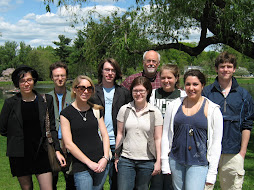
George Arthur (Photo by Rafal Wilson)
By Dora Wilkenfeld, Christine Sullivan, Justin Maher and Samantha Henry
George Arthur bounds up the trail with the enthusiasm of an overgrown Boy Scout, pointing out witch hazel and ladyslippers along the path. After pausing a moment to note the four distinct leaf varieties on a sassafras shrub, he's off again, up the steep, rocky route of the Shenipsit Trail in Vernon, Conn.
For a man past retirement age, such exertion here in the Valley Falls Park on a hot and sunny day might be almost excessive. For Arthur, a trail manager with the Connecticut Forest & Park Association, it's all in a day's work.
The trail association, based in Rockfall, Conn. has been working since 1895 to conserve land with a high priority being its 800-mile Blue-Blazed Hiking Trail System and its related trails scattered throughout Connecticut.
Keeping the trails in tip-top shape can be an easily underestimated task; duties include blazing the way with the distinguishing blue paint, clearing stray branches for safe passage, eliminating litter to beautify the path, and acquiring permission to transverse certain privately owned properties.
And perhaps what is most remarkable about the achievement of this colossal task is that it is nearly all the result of volunteer efforts from dedicated individuals like Arthur.
No challenge is greater for trail managers like Arthur then to build and expand trails, especially in more developed areas such as Vernon.
"There wasn't anything in Vernon 14 years ago," Arthur says of the now-abundant trails stretching through the town and beyond. "Vernon was pretty well developed." The town today is a mix of residential and business areas, close to both the city of Hartford and the endless shopping plazas of Manchester.
Sections of the trail are owned by different people, from the state, to private landowners, and everything in between, such as electric companies. To make the trail continuous, Arthur must negotiate with an indeterminate amount of varied landowning entities. The trail system’s natural beauty is a testament to the dedication of its volunteers.
“I was hoping to get my trail through there,” Arthur said, pointing to a field to the right of the Blue Blaze Trail next to the Walker Reservoir in Vernon. “But it’s not going to happen if Home Depot gets their way.”
The national retailer purchased land near the reservoir two years ago, although the sale has been tied up in a court dispute, said Arthur.
Arthur knows all of the details, he estimates that he volunteers about 300 hours a year to the trail association.
"If I had read the job description, I probably wouldn't have taken the job in the first place," Arthur jokes, but it's clear that he's serious about committing his time to maintaining and beautifying his trails. A colleague, Rob Butterworth, describes Arthur as "the guy the other trail managers talk to when they need to put in something big," typically a bridge or other structure crossing the path.
Uncooperative property owners aren't the only problem Arthur and the other trail manager’s face.
"In a lot of towns, including this one, you have what we call vandals," Arthur says. "You have to keep a close eye to keep things from becoming hazardous."
What is allowed on the trails varies. Butterworth said that almost all trails are for hikers only. Biking often is, but it varies depending on the whims of the landowner of each section of trail.
All terrain vehicles have been a problem in the past, but with a local town ranger chasing them out the numbers have gone down significantly.
“It’s unfortunate that people think they qualify for the X-Games and tear up the property,” Butterworth said.
Water damage is another big problem on any trail. If it doesn’t drain off of the trails properly, it erodes them.
One section of the trail features land that was given to the state by Maxwell Belding, whose family had owned a major textile complex in the town. A bridge crosses a man-made pond and dam over to a path made of stone dust. This is for wheelchair accessibility, so everyone can enjoy the scenery. The bridge featured here is one of many structures along the Blue Blaze Trail.
Many of the paths in the Blue Blaze Trail were begun about 75 years ago as Connecticut residents began to move to the cities and began to long to get back into the country on a weekend afternoon. Today the paths run over mountains and near interstate highways but still provide residents and visitors the opportunity to get outdoors and experience the natural side.
For a man like Arthur, who partook in the Air Scouts as a boy and learned to pilot an airplane before he could drive a car, the appeal of the outdoors is almost second-nature, something he hopes to preserve for future generations of exploration-minded youths and adults alike. And he is extremely proud of his work and accomplishments.
“Our trails are world class trails,” Arthur said. “I keep it clear – brushing, clipping, and sawing.”

No comments:
Post a Comment